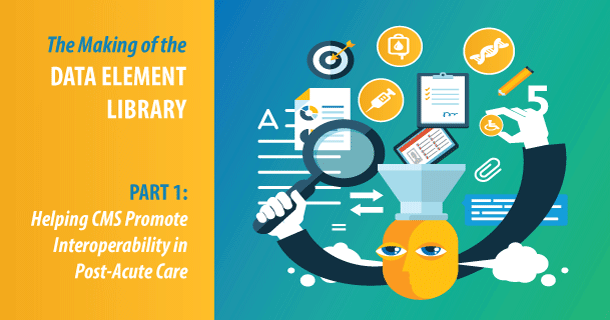- Telligen’s development team helped the Centers for Medicare and Medicaid Services deliver a new database, the Data Element Library, to advance the exchange of electronic health information in post-acute care settings.
- The Data Element Library is a free, centralized resource that allows providers, vendors, researchers, and the public to view patient health assessment data from PAC facilities, such as nursing homes and rehabilitation hospitals.

Promoting Interoperability in Post-Acute Care
The ability for healthcare providers to access the right information at the right time is essential to smart decision-making. No one understands this better than the post-acute care providers charged with safely transitioning patients from the hospital to a PAC facility (e.g., nursing home, home health agency, long-term care hospital, and inpatient rehab facility).
Interoperability, or the ability to exchange data across systems, helps PAC providers improve patient safety and decrease avoidable hospital readmissions and emergency department visits.
What is Interoperability?
When applied to healthcare, interoperability enables systems to connect and exchange information with one another, even if they were developed by different manufacturers.
Why is Interoperability a Challenge in Post-Acute Care?
Upon admission to PAC facility, providers must collect a range of data to assess a patient’s health and functional status. Each facility typically uses some type of technology, like an EHR, to collect, manage, and submit patient assessment information to CMS.
For PAC facilities, these technologies can be perceived as costly and time-consuming. Issues with staff turnover and lack of financial incentive for Meaningful Use of EHR technology, result in multiple technologies made by multiple vendors that do not “speak the same language” and are unable to exchange information.
The IMPACT of Interoperability
In September 2014, Congress passed the IMPACT Act (Improving Medicare Post-Acute Care Transformation). At the time, patient assessment data was standardized across the different PAC settings. So, a skilled nursing facility, a physical rehabilitation center, and other PAC settings might ask completely different sets of questions during patient assessments and use different ways to record that information.
Mandated assessments within differing facilities include:
- Skilled Nursing = Minimum Data Set (MDS)
- Inpatient Rehab = Patient Assessment Instruments (PAI)
- Home Health = Outcome and Assessment Information Set (OASIS)
- Long-Term Care = CARE Data Set
- Hospice = Hospice Item Set (HIS)
What is the Goal of the IMPACT Act?
To create a seamless flow of information that can be exchanged electronically with all the patient’s care providers, including the next provider of care.
In PAC, a “seamless flow of information” means standardizing assessments across all settings, so providers can compare apples to apples when making patient care decisions.
From IMPACT to the Data Element Library
As part of the IMPACT Act, CMS was charged with designing, building, and implementing a database (e.g., The Data Element Library) that helps standardize the thousands of data elements used across multiple assessment instruments in PAC facilities.
Stay Tuned . . .
The Making of the Data Element Library: Part 2. Learn how the Telligen team:
- Met CMS’ 15-month deadline
- Overcome Agile & cloud-based challenges
- Created value for CMS, healthcare facilities & providers, EHR vendors, and the public

